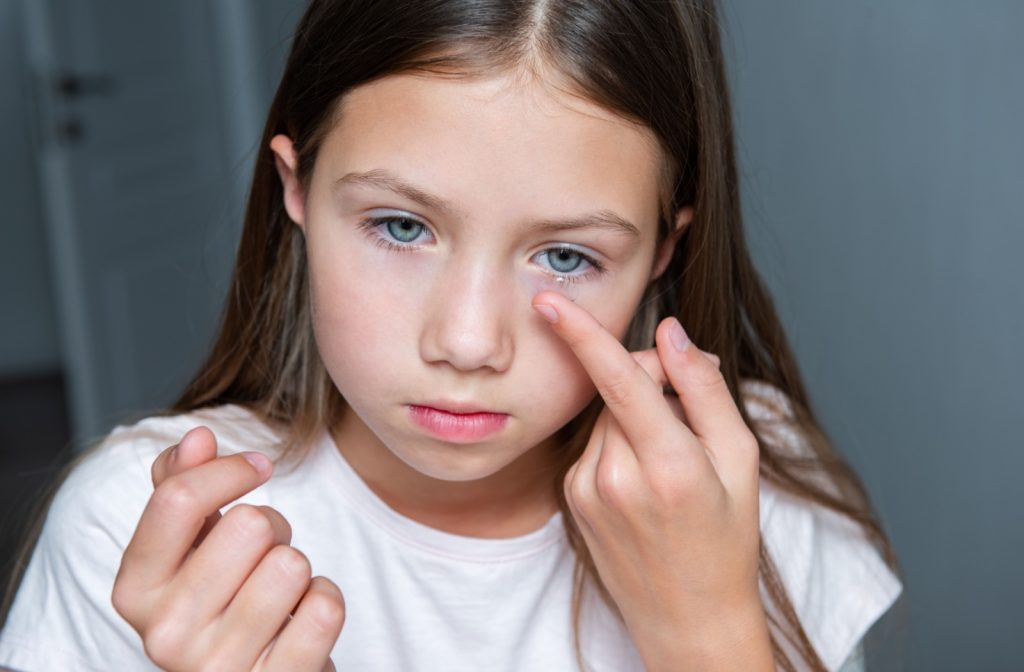You’ve noticed your child squinting at the TV or holding books closer to their face. Maybe they’ve complained about not being able to see the board at school clearly. As a parent, you naturally wonder if there’s a way to fix this vision problem permanently. Calgary Optometry Centre understands these concerns and helps families navigate their options for myopia control.
Myopia cannot be reversed or cured because the underlying eye structure changes are permanent, but effective treatments can slow its progression and provide clear vision correction.
What Is Myopia & Why It Develops
Myopia, commonly called nearsightedness, happens when your child’s eye grows too long from front to back. This causes light to focus in front of the retina instead of directly on it. Your child can see nearby objects clearly, but distant things look blurry. The basics of myopia help you recognize when your child needs professional evaluation.
How Your Child’s Eyes Change Over Time
Your child’s eyes continue growing throughout childhood and adolescence, just like the rest of their body. When myopia develops, the eye typically keeps getting longer until your child reaches their early twenties.
This means your child’s prescription often gets stronger each year during their school years. Progressive myopia can lead to higher prescriptions and increased risks for eye health complications later in life.
Common Causes Your Family Should Know
Genetics play a major role — if you or your partner have myopia, your children are more likely to develop it too. However, lifestyle factors also contribute significantly to myopia development. Several factors can accelerate myopia progression in children.
Too much screen time and close-up activities like reading put strain on developing eyes. Children who spend less than two hours outdoors daily also face higher myopia risks.
The Truth About Reversing Myopia
No treatment can make an elongated eye shorter again. Once your child’s eye has grown longer due to myopia, that structural change is permanent. This is why myopia cannot be truly reversed or cured. Research confirms myopia as a public health issue requiring proactive management rather than hoping for cures.
Why “Miracle Cures” Don’t Work
You might see advertisements for eye exercises claiming to cure myopia naturally. These exercises cannot change the physical length of your child’s eye, so they won’t eliminate nearsightedness.
Similarly, special vitamins or supplements cannot shrink an eye that has grown too long. Some dangerous practices involve pressing on the eyes, which can cause injury without providing any vision benefits.
What Correction Really Means
Vision correction helps your child see clearly by redirecting light properly onto the retina. However, correction doesn’t change the underlying eye structure that causes myopia.
Think of it like wearing a cast for a broken bone — the cast helps the bone function properly, but the bone still needs to heal on its own.
Effective Ways to Slow Myopia Progression
While myopia can’t be reversed, proven treatments can significantly slow how quickly it worsens in children. These myopia management options help protect your child’s long-term eye health. Several proven strategies can prevent myopia from worsening when implemented early.
Specialized Contact Lenses
Orthokeratology lenses reshape your child’s cornea overnight while they sleep. Your child removes these special lenses in the morning and enjoys clear vision all day without glasses or contacts.
Multifocal contact lenses work differently by providing multiple focus points throughout the day. Both options have shown good safety records and can slow myopia progression by 30-60% in many children. Multifocal contacts offer effective myopia control for many children.
Atropine Eye Drops
Low-dose atropine drops applied nightly can help slow the eye’s growth rate. Your child receives a tiny amount of this medication in each eye before bedtime.
This treatment has proven particularly effective for children and teens, often reducing myopia progression by 50% or more when used consistently.

Vision Correction Options for Clear Sight
Several reliable methods can give your family members clear, comfortable vision while managing their myopia effectively. Different contact lens types offer various benefits for people with myopia.
Glasses & Regular Contact Lenses
Traditional glasses provide immediate vision correction and work well for children of all ages. Regular contact lenses offer more freedom for active kids who play sports or prefer not wearing glasses.
Updated prescriptions help your child see clearly as their eyes change. Modern frames and lenses are lightweight and durable, making them comfortable for daily wear.
Laser Eye Surgery for Adults
Adults over 18 with stable prescriptions may consider laser eye surgery for permanent vision correction. This surgery reshapes the cornea to redirect light properly onto the retina. Laser eye surgery options help adults make informed decisions about vision correction.
However, surgery doesn’t change the underlying elongated eye shape, so the eye health risks associated with high myopia remain.
Daily Habits That Support Your Child’s Eye Health
Simple lifestyle adjustments can help protect your child’s developing vision and may slow myopia progression naturally. Playing outdoors regularly helps maintain children’s eyesight and reduces myopia risk.
Outdoor Time & Sunlight
Aim for at least two hours of outdoor activity daily for your children. Natural sunlight appears to help regulate healthy eye growth during development.
Outdoor time doesn’t require intense physical activity — reading outside, walking, or playing in the yard all provide benefits. Just make sure your child wears appropriate sun protection.
Smart Screen Time Management
Teach your family the 20-20-20 rule: every 20 minutes, look at something 20 feet away for 20 seconds. This gives your child’s focusing muscles regular breaks from close work. The 20-20-20 rule effectively reduces eye strain from digital device use.
Limit smartphone use for younger children and provide good lighting when your child does homework or reads. Proper ergonomics reduce eye strain during screen time.
Regular eye exams help detect myopia early and monitor its progression. Early intervention often leads to more effective myopia management outcomes. Children’s eye exams provide comprehensive vision assessment and early problem detection.
Signs Your Child May Have Myopia
- Squinting to see distant objects
- Sitting close to screens or books
- Complaints about blurry vision
- Frequent headaches or eye strain
What to Expect During the Visit
A comprehensive eye examination includes testing your child’s visual acuity, eye coordination, and overall eye health. The doctor uses specialized equipment to measure eye length and track any changes over time. Comprehensive eye exams help detect eye diseases and monitor your child’s vision development.
Our team at Calgary Optometry Centre can discuss personalized myopia management options that fit your family’s lifestyle and your child’s specific needs. Call today to schedule your child’s comprehensive eye exam and learn about the most effective approaches for managing their vision.




